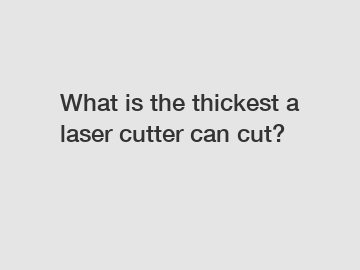Nov. 24, 2023
Machinery
When it comes to precision and versatility in cutting materials, there's no denying that laser cutters have revolutionized countless industries and hobbies alike. From intricate designs on cardboard to precise engravings on wood, these powerful machines have become a staple tool for creators worldwide. However, one question that often arises in the minds of laser cutter enthusiasts is, "What is the thickest a laser cutter can cut?" In this blog, we will dive deep into the world of laser cutting and explore the limits of these impressive machines.
Understanding Laser Cutting:
Before we can answer the question at hand, let's briefly touch upon the process of laser cutting. In simple terms, a laser cutter uses a high-powered laser beam to slice through various materials, following precise paths dictated by computer software. It accomplishes this through a combination of heat, melting, vaporization, and even blowing away the molten material from the cutting area.

Factors That Influence Cutting Thickness:
1. Laser Cutter Power:
The most influential factor determining a laser cutter's cutting capabilities is its power output. Generally measured in watts, laser cutters range from low-powered ones suitable for hobbyists (around 20-60 watts) to industrial-grade machines capable of producing up to 10,000 watts. As the laser's power increases, so does its ability to effortlessly cut through thicker materials.
2. Material Density and Reflectance:
Another factor impacting the maximum thickness that a laser cutter can handle is the density and reflectance of the material being cut. Materials like acrylic and wood tend to have favorable properties for laser cutting due to their lower reflectance, allowing the beam to penetrate more effectively. Conversely, highly reflective materials like metals may require higher laser cutting power or alternative methods such as fiber laser cutting.
3. Focal Length and Beam Diameter:
The focal length of the laser cutting lens and the beam diameter also play a significant role in determining the cutting thickness. In general, shorter focal lengths and smaller beam diameters result in increased power density, allowing for deeper and cleaner cuts. This is especially important when working with denser materials.
Exploring the Limits:
While laser cutters are versatile tools, their ability to cut thicker materials is ultimately limited by several factors, as discussed above. The maximum thickness a laser cutter can achieve may vary depending on the machine's power, build quality, and the material being cut. However, it is generally accepted that most hobbyist-grade laser cutters can handle materials in the range of 6-12mm thickness.
For industrial laser cutters with higher power outputs, the potential thickness increases. Machines capable of around 150 watts can cut through materials up to approximately 20mm thick, whereas those equipped with 500 watts or more can handle even thicker sheets, reaching up to 25-30mm in thickness.
Going Beyond the Limitations:
But what if you need to cut even thicker materials? Several alternative methods can overcome the limits of traditional laser cutting. These include:
1. Multiple Passes:
By making multiple passes over the same area, gradually increasing the cutting depth, it is possible to cut through thicker materials. However, this approach requires careful alignment, as any deviations in the successive passes may result in inaccurate and imprecise cuts.
2. Kerf Adjustments:
Adjusting the laser beam's focus and power settings to modify the kerf (the width of material removed during cutting) can enhance a laser cutter's capacity to cut through thicker sheets. This technique requires experimentation and fine-tuning to strike the right balance between cutting through the material and ensuring the integrity of the finished piece.
Conclusion:
In the realm of laser cutting, the maximum thickness a laser cutter can handle is a dynamic concept influenced by various factors. From the power of the laser and the properties of the material to the focal length and beam diameter, each parameter plays a crucial role in shaping the cutting capacity of these machines. While hobbyist-grade laser cutters may comfortably handle materials up to 6-12mm in thickness, industrial-grade machines with higher power outputs can tackle thicker sheets. However, when seeking to cut materials beyond these limits, alternative methods like multiple passes and kerf adjustments can empower the laser cutter to surpass expectations.
Ultimately, understanding the capabilities and limitations of laser cutting technology allows creators to embark on projects with realistic expectations while pushing the boundaries of creativity and precision in their crafts.
The company is the world’s best customized single platform fiber laser cutting machine, Double-Platform Exchange Laser Cutting Machine supplier, Double-Platform Exchange Laser Cutting Machine supplier supplier. We are your one-stop shop for all needs. Our staff are highly-specialized and will help you find the product you need.
Previous: Which metal is better for a printed circuit board?
Next: What are the advantages of purchasing a High Speed Gravure Printing Machine for your business?
If you are interested in sending in a Guest Blogger Submission,welcome to write for us!
All Comments ( 0 )